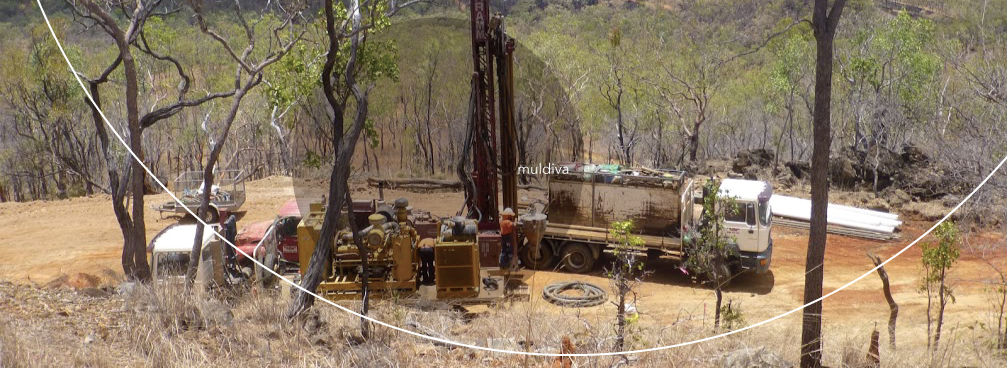Muldiva
Government records state that approximately 20,000 tons of ore was mined from the Muldiva workings. The records should be used as a guide only as they are mostly estimates. There were two mines that produced the bulk of the ore. The mines were the Eclipse and the Paisley mines. At both these mines a considerable amount of ore was obtained by open cut mining methods. The underground workings are down to 51 metres in both the Paisley and Eclipse mines.
At the Muldiva mine, assay results returned ore grade silver and copper. There are many other satellite deposits where ore occurs near surface with silver being the main mineral of economic interest. Any of these prospects could hold sufficient ore to support a mining operation. Further exploration is required to confirm.
Approximately 3 km to the west of Muldiva is the Kernell prospect. This is a copper molybdenite prospect with silver and gold credits. This prospect has similar features to that of some copper molybdenite porphyry deposits. C.R.A recorded copper and molybdenite anomalies in the area.
The Muldiva mines where initial bulk testing and mine development may take place are serviced by good access roads, to within 200 metres of the proposed pit sites. A major electric power line is nearby, about 3 km away from the proposed plant site at Muldiva. Due to ongoing mining activities being carried out in the area for over a century, no objections to mining the area from the local people would be expected.
There are many personnel with skills regarding mining and exploration in North East Queensland, therefore skilled labour would be obtainable including contractors, drilling companies, earthmoving contractors as well as metallurgists and assaying companies.
Muldiva was mined in a small way for base metals and silver early last century. Several explorers have investigated the property in recent decades, and carried out limited drilling programs on the two historically named deposits. OzCrest’s involvement since 2012 culminated in a small 6 hole orientation and due diligence drilling program on the Paisley deposit in late 2012. The Resource Summary is now based on a combination of OzCrest’s recent drilling and on the previous drilling. Estimation was performed by geological consultancy GeoRes’s Competent Person, Robin Rankin.
Resources were individually estimated and reported by GeoRes - July 2013 for Paisley (Under JORC 2004) and in December 2014 for Eclipse (under the current JORC 2012. Muldiva has combined Paisley and Eclipse deposit JORC Indicated and Inferred zinc Mineral Resources of 1.1Mt @ 4.8%zinc (at a 1% lower zinc cut-off). Muldiva has an additional combined Exploration Target of 0.9 to 2.6 Mt @ 3 to 8% zinc. The estimate assumes "lode extension" at both deposits.
Resources were individually estimated and reported by GeoRes - July 2013 for Paisley (Under JORC 2004) and in December 2014 for Eclipse (under the current JORC 2012. Muldiva has combined Paisley and Eclipse deposit JORC Indicated and Inferred zinc Mineral Resources of 1.1Mt @ 4.8%zinc (at a 1% lower zinc cut-off). Muldiva has an additional combined Exploration Target of 0.9 to 2.6 Mt @ 3 to 8% zinc. The estimate assumes "lode extension" at both deposits.
The Muldiva deposit is located within the Palmerville Fault and is dominated by calcic skarn formed by replacement of limestone adjacent to the contact with the Permo-Carboniferous Quaker and Ootann granitoid.
Government records state that approximately 20,000 tons of ore was mined from the Muldiva workings. The records should be used as a guide only as they are mostly estimates. There were two mines that produced the bulk of the ore. The mines were the Eclipse and the Paisley mines. At both these mines a considerable amount of ore was obtained by open cut mining methods. The underground workings are down to 51 metres in both the Paisley and Eclipse mines.
At the Muldiva mine, assay results returned ore grade silver and copper. There are many other satellite deposits where ore occurs near surface with silver being the main mineral of economic interest. Any of these prospects could hold sufficient ore to support a mining operation. Further exploration is required to confirm.
Approximately 3 km to the west of Muldiva is the Kernell prospect. This is a copper molybdenite prospect with silver and gold credits. This prospect has similar features to that of some copper molybdenite porphyry deposits. C.R.A recorded copper and molybdenite anomalies in the area.
The Muldiva mines where initial bulk testing and mine development may take place are serviced by good access roads, to within 200 metres of the proposed pit sites. A major electric power line is nearby, about 3 km away from the proposed plant site at Muldiva. Due to ongoing mining activities being carried out in the area for over a century, no objections to mining the area from the local people would be expected.
There are many personnel with skills regarding mining and exploration in North East Queensland, therefore skilled labour would be obtainable including contractors, drilling companies, earthmoving contractors as well as metallurgists and assaying companies.

